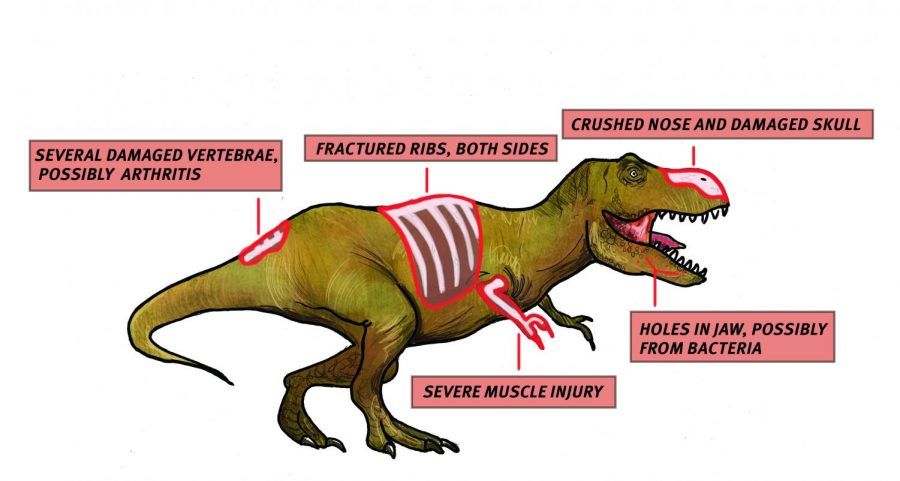SUE reveals answers millions of years after death
SUE reveals answers millions of years after death
October 17, 2016
SUE, the largest and most complete Tyrannosaurus rex ever found, had her right arm removed Oct. 6 to help scientists discover more about what T. rex’s arms were used for, and why they were so small.
Carmen Soriano, a beamline scientist at Argonne National Laboratory, in Lemont, Illinois, is one of two experts studying SUE’s arm. Beamline scientists use accelerated particle scanning technology to study material. Soriano said she worked over the weekend to scan the arm and added that the bones were returned to Chicago’s Field Museum, 1400 S. Lake Shore Drive, Oct. 12.
Soriano, who said her specialty is studying insects preserved in amber, said she became interested in the project because she also works with the Field Museum and spoke with colleagues in France about a larger effort to study the T. rex that they are working on. She added that preliminary results showed SUE did not use her arms very much.
“It shows in the bones,” Soriano said. “We can see a lot of hollow spaces that have not been regrown. That’s very typical when bones are underused.”
According to Soriano, an injury to SUE’s arm is a focus of the study, which was conducted using a synchrotron—an instrument that uses microscopic particles to scan material. Soriano said this method allows scientists to see individual cells and analyze any soft tissues, like skin, that remain on the bone.
SUE’s arm has extensive muscle damage, and Soriano said this could have been because of a cyst, an injury from an attack, or bone disease. She said carnivores, like SUE was, lead dangerous lives and sustain heavy injury.
“SUE is really beat up,” Soriano said. “The lion today is a similar predator. [Carnivores] have a really tough life.”
Though scientists are not sure what happened to SUE’s arm, many of them have theories about T. rex’s small limbs. Pete Larson, one of the scientists who discovered SUE and president of the Black Hills Institute which excavates and prepares fossils, said he thinks T. rex used its small but strong arms to hold prey close to their bodies while adjusting their jaws to kill victims. He also said the limbs could have been small to balance out huge, heavy skulls.
John Hutchinson, professor of evolutionary biomechanics at the Royal Veterinary College in the UK, who has published research and 3D models of how T. rex grow over their life span, said in an Oct. 11 emailed statement that he does not think the question of the use of a T. rex’s arms is scientifically valuable and T. rex simply stopped using their arms over time, comparing them to human appendices.
Mary Schweitzer, a biological science professor and research curator at North Carolina University who confirmed the authenticity of the world’s first pregnant dinosaur through chemical analysis of its bones, has studied SUE in the past. She said T-rex arms are a mystery and added that T. rex’s mated and evolved to have smaller arms.
SUE’s journey to the Field Museum took several years, and her move only happened after multiple court cases deciding her ownership. Larson is part of SUE’s complicated story, and though he was unable to keep and display her, Larson said he is happy SUE is still educating people.
“She kind of belongs to everybody,” Larson said. “It’s her job in life, and in death now, too, to reveal her secrets.”
Both Schweitzer and Soriano share that sentiment, and Soriano said SUE is not only beloved by Chicagoans. She said SUE is famous in her native Spain as well.
“SUE has such a story behind her,” Soriano said. “You have to love her. There is no other option.”








